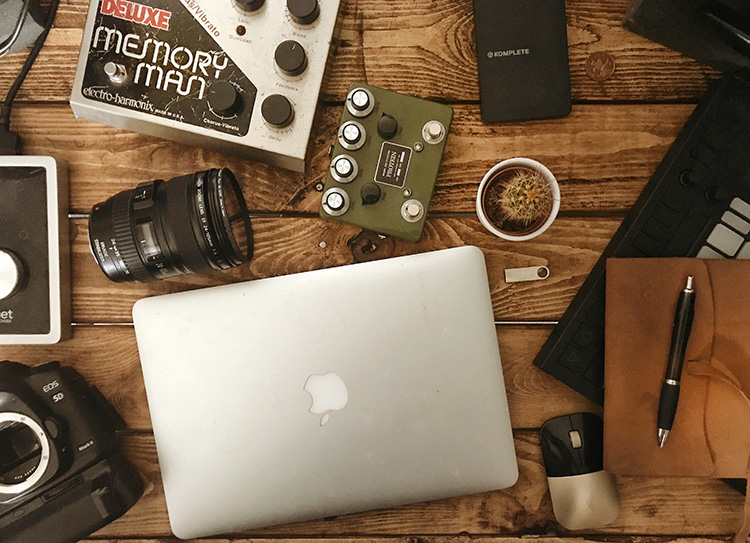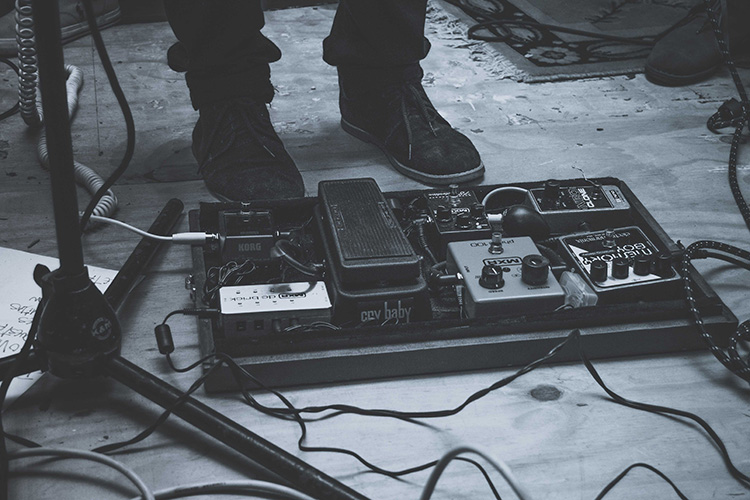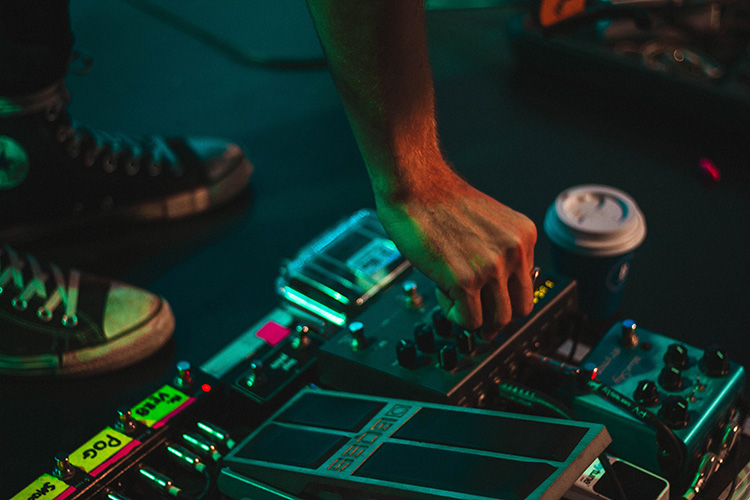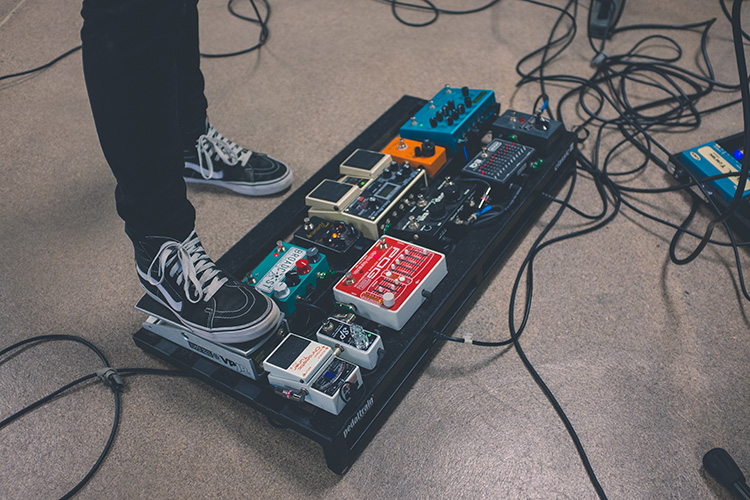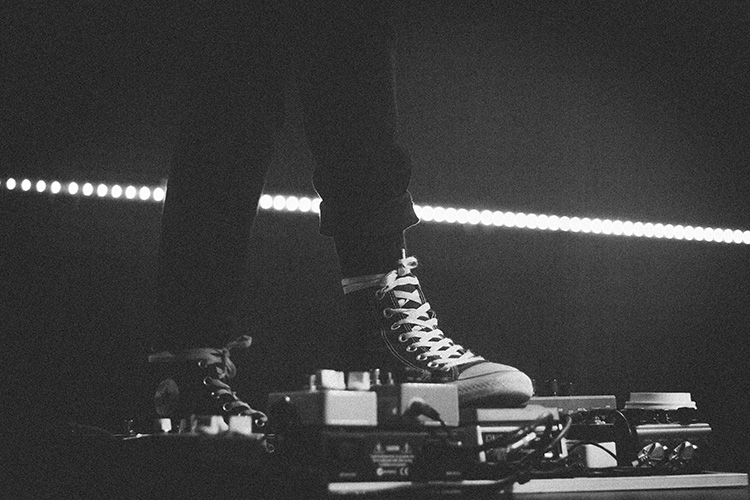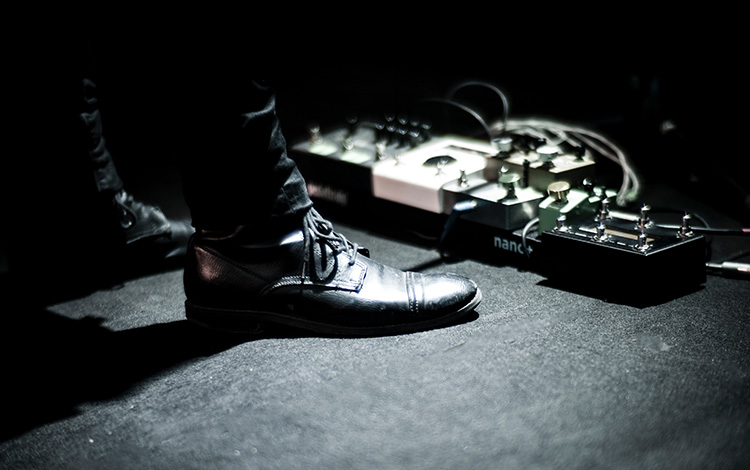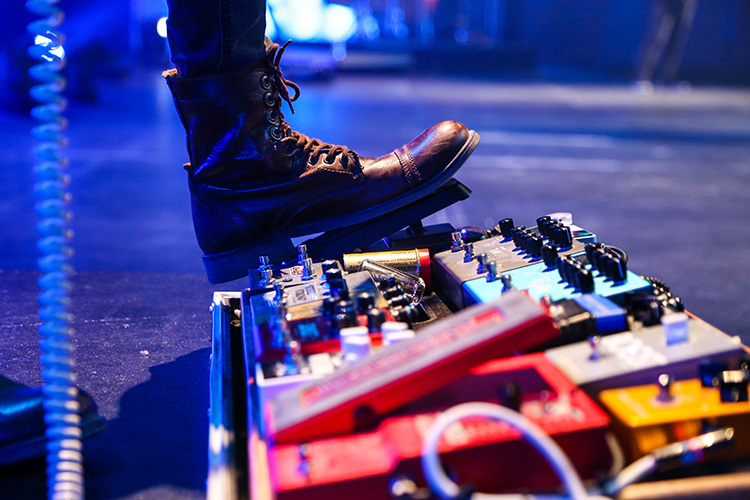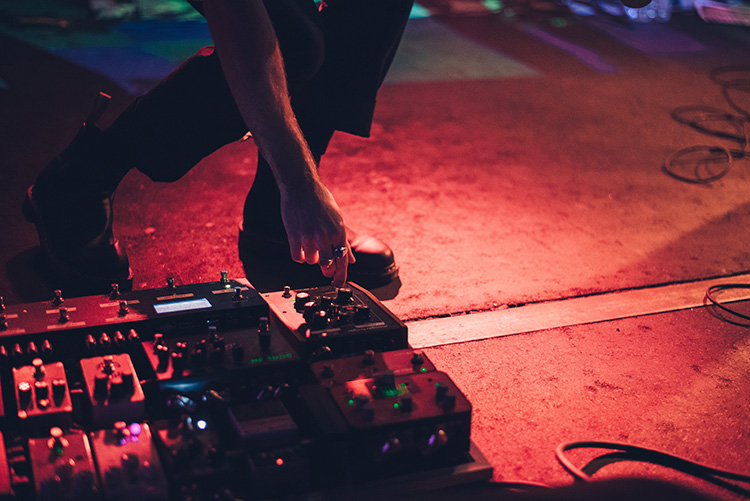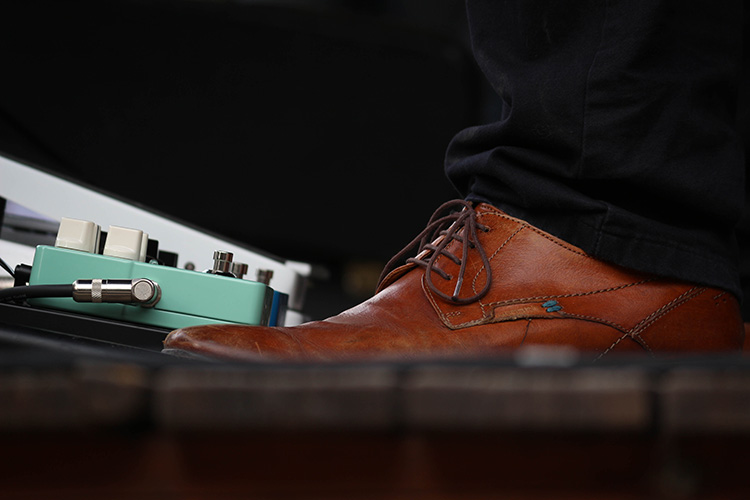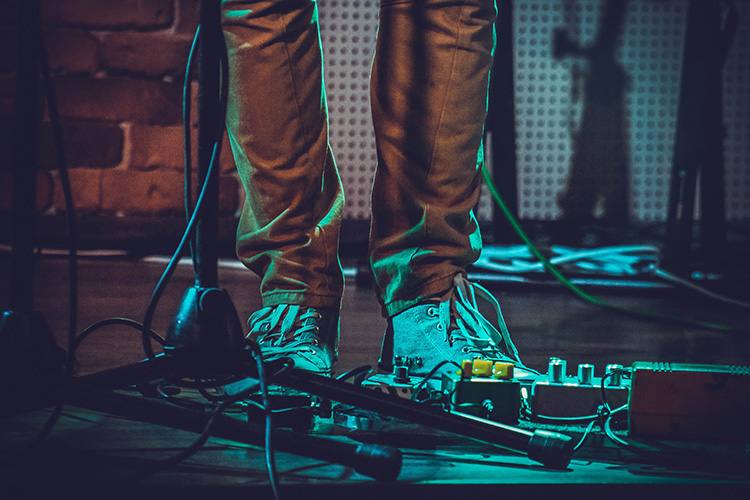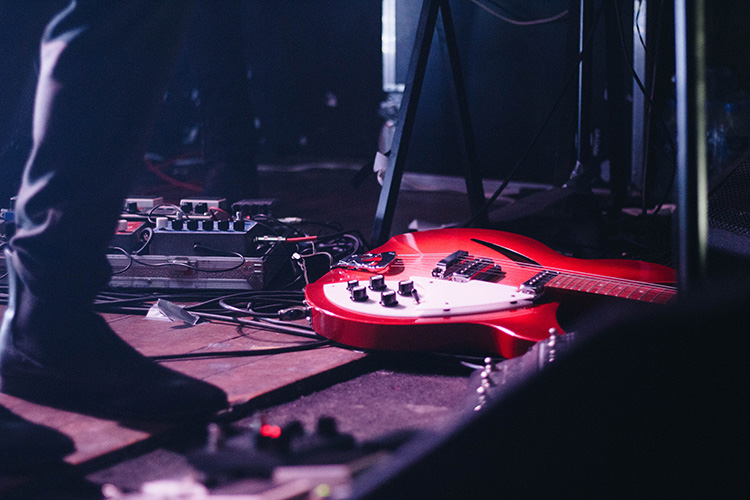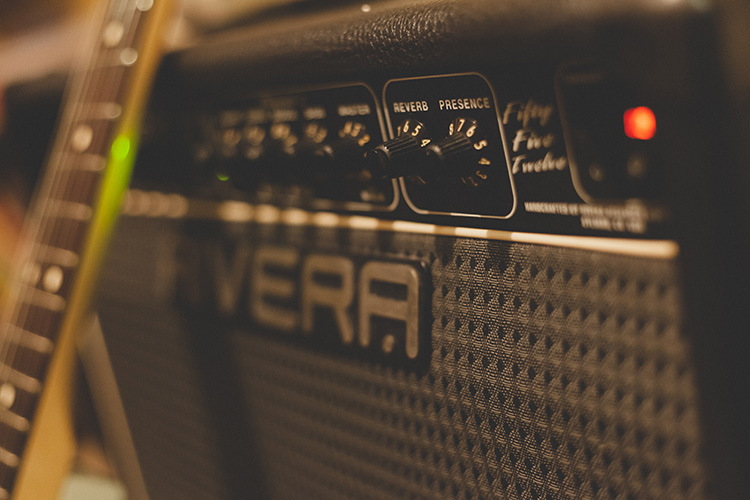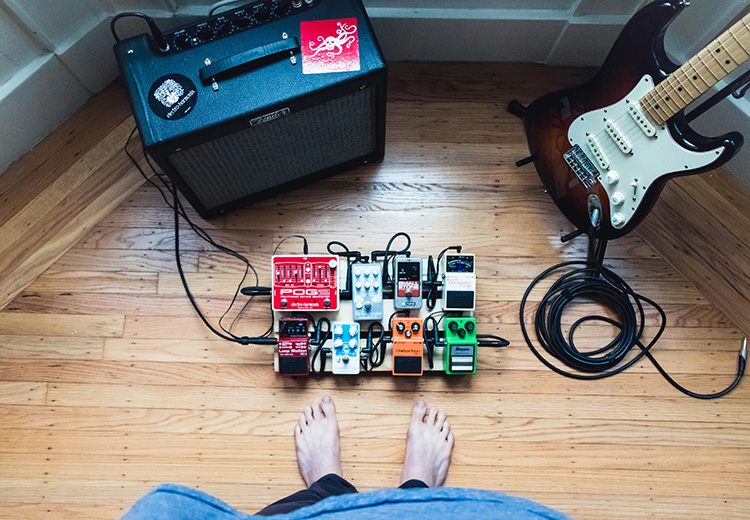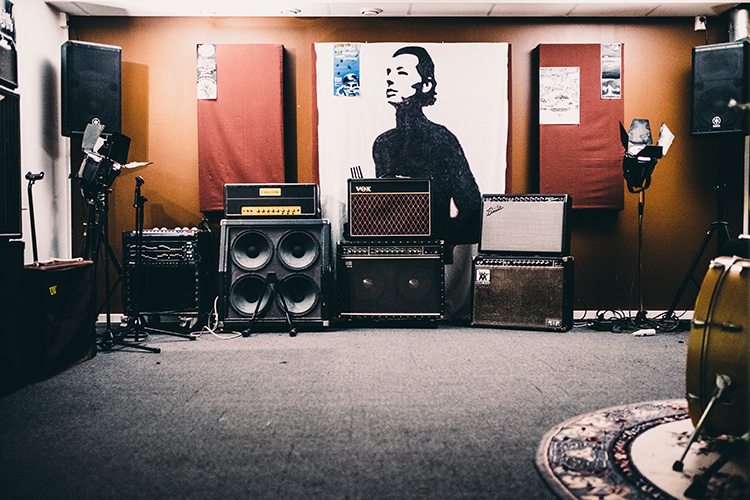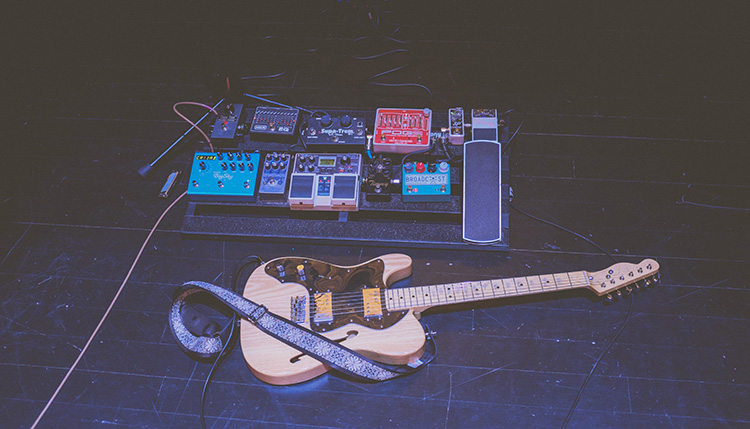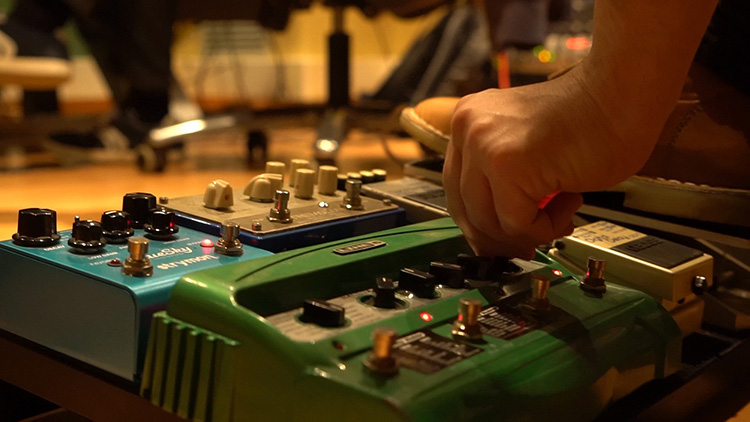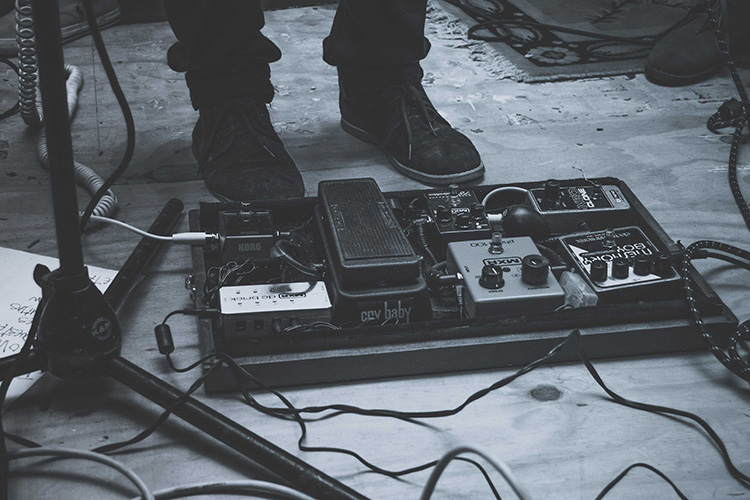Building a pedalboard can be overwhelming – Let us break down the most essential guitar pedals for your first pedalboard!
Over 250,000 guitar-learners get our world-class guitar tips & tutorials sent straight to their inbox: Click here to join them
In this free lesson you will learn…
- The five most essential styles of guitar pedal
- How to build an essentials-style pedalboard
- Tips for building a pedalboard
- How to position your guitar pedals in a signal chain
What Are The Best Guitar Pedals For Beginners?
Unless you’re entirely sworn to playing the acoustic guitar completely unplugged throughout your entire musical journey, you can guarantee that at some point you’ll start experimenting with guitar pedals.
- These handy little devices come in all shapes and sizes, and there are literally thousands of them to choose from when it comes to building a good starter pedalboard.
- With all these options though, it leaves us wondering what the best guitar pedals for beginners might be.
We want to answer the question of what the bare essentials might be for any guitarist looking to build their first essentials-style pedalboard.
Pro Tip: Don’t be fooled! You may see plenty of guitarists and other musicians who sport fancy and massive pedalboards, but a lot of that is quite unnecessary.
- An effective essentials-style pedalboard doesn’t have to be excessive at all, and we can get extremely far with very little when it comes to using guitar pedals for beginners.
- In this article, we’re going to strip away all of the fancy stuff and show you the 5 most essential styles of pedal that should go on your first pedalboard.
Get ready to make some noise, but first let’s look at how to go about building a pedalboard!
Learning How To Build A Pedalboard From Scratch
There seems to be quite a bit of math on the surface of building a pedalboard, but it doesn’t have to be that complicated.
Often the best way to build a DIY pedalboard from scratch is using a plank of wood, or even an old skateboard deck! Just make sure you’ve measured enough space to fit all your pedals!
Pro Tip: Velcro is your best friend. No matter what you build your pedalboard on top of, you’re going to want some heavy-duty velcro that will hold plenty of weight.
Once you’ve constructed your board out of the best guitar pedals for beginners in this guide, you’ll want to make sure they don’t move.
Guitar pedals take a beating with your feet and they are built extremely tough, but you’ll need to make sure they’re fastened down tightly. Heavy-duty velcro is always the way to go.
We also recommend that you get yourself a set of short L-style guitar cables.
- These cables are built to connect pedals together in short ranges, so they’re ideal for building a compact pedalboard out of the guitar pedals for beginners that you’ll read about here.
- These cables can be purchased in packs like this one here, and they make it super easy to keep things compact.
Pro Tip: A cable can die at any time for any number of reasons. Keep a few extras in your guitar bag at all times!
Remember: Better safe than sorry!
The last thing you may need is a power supply.
Although these aren’t necessary, they do make life a lot easier by helping us avoid swapping batteries constantly.
Many guitar pedals can be battery-operated, but if one of them dies in the middle of a practice session (or worse, a performance) you’ll be stuck trying to find the dead culprit that’s causing your signal to break down.
Power supplies are reliable, and we recommend the 1Spot Power Supply from TrueTone. You can find it here.
Download our lead guitar cheat-sheet to make things easier
It's hard to understand which scales work with which keys.
So we created a cheat-sheet! A key and scale-finder that you can use again and again.

Get your personalised guitar-learning plan 🎸
Get a custom guitar-learning plan here: Click here for GuitarMetrics™
World-Class Guitar Courses 🌎
Learn from the world's best guitar educators: Click here for our guitar courses
Why Are Guitar Pedals Important?
There is often only so much that we can do with an amplifier. Although many of them give us a variety of tonal options, many of them are limited to one or two channels.
- The ideal set of guitar pedals for beginners will help us explore new guitar tones, as well as shape the tone we have now into something we love even more!
- Guitar pedals help us with customization.
Every guitarist has a sound, whether they realize it or not, and the right set of guitar pedals for beginners will help us unlock all sorts of new sonic territory in the early stages of learning guitar.
Pro Tip: Guitar pedals for beginners aren’t at all necessary. We can get by simply by playing through our amplifier and most often we can get a pretty amazing array of sounds just by tweaking the tone.
Building a pedalboard, however will teach us much more than just how to chase guitar tone – it will also teach us the foundation for how to wire pedalboards, as well as how to experiment with sound.
- One of the coolest things that we encourage you to do is experiment with the placement of your pedals in your signal chain.
- We’ll give you some suggestions throughout this guide as to where you should place your pedals in the chain, but experimentation can lead to some interesting results!
Now, on to our top five types of guitar pedals for beginners!
Guitar Pedals For Beginners – Distortion
Everybody wants their amp to scream a little louder, and that’s what distortion pedals are for!
- These pedals break up our guitar’s signal and – you guessed it – distort it. This can result in some pretty amazing sounds that we can use for heavier styles of music like Rock, Punk and Heavy Metal.
- Distortion pedals can also be dialed back too! We can use these pedals to add ‘breakup tone’ to our signal.
- Breakup tone is the sound of our amp being pushed just past its comfort zone so that the signal stays clean but with just the right amount of dirt on top.
This can work very well for strumming chords with a bit more bite.
Distortion pedals should typically sit pretty early on in your guitar pedal chain. Putting this pedal right in front of an amp is a great way to achieve a dirty guitar tone.
If you have modifier-style pedals in your board, make sure they come after your distortion pedal.
Pro Tip: Avoid putting your distortion pedal after your reverb pedal unless you want a wall of noise.
Distortion-style guitar pedals for beginners that we recommend include:
- BOSS DS-1
- Fulltone OCD
- Ibanez Tube Screamer (This one functions more like a boost and less like a distortion pedal)
Next, let’s talk about how we can tighten up our guitar’s signal
Guitar Pedals For Beginners – Compressors
When we’re playing with guitar pedals for beginners, our signal can get out of control pretty fast.
We want something that’s going to squash our guitar signal a bit and keep it under control, and that’s where the compressor comes in.
Fun Fact: Compressors were used originally on radio broadcasts to control the range of volume on the human voice.
- This was preferable so that people wouldn’t hurt their ears while listening to the radio.
- Compressors provided a ceiling for volume that the radio hosts could not exceed, making the broadcast safe to listen to.
These guitar pedals work much the same way.
Compressors can work one of two ways:
- To boost and tighten our signal (functioning as a compressor), or
- To create a volume wall that our guitar cannot exceed (functioning as a limiter)
Each compressor is a little bit different in how it’s laid out, but compressing and limiting are a compressor’s two essential functions.
It always helps to have a bit more control over where our sound goes and how much of it we use. Compressors are a fantastic way to gain more control over your guitar’s signal.
Try using a compressor pedal before or after your distortion pedal for different results!
Compressors we recommend are:
Next, let’s add some space!
Guitar Pedals For Beginners – Reverbs & Delays
Reverbs add space & room sound to our list of useful and handy guitar pedals for beginners.
- Although many guitar amplifiers have reverb built into them, having an external reverb pedal gives us more control over the space that our guitar takes us.
- From everything from a tight and slappy sound to an ambient space that makes your guitar sound like it’s underwater, reverbs can colour our guitar a thousand different ways.
These pedals are best utilized at the end of a signal chain to colour our guitar tone nicely on the way to the amplifier.
Reverbs we recommend include:
Delays also help to add space to our signal, but in a different way.
Pro Tip: “Delay” is just a fancy term we musicians coined for “echo.”
- Delay pedals generate repeated echoes of our guitar.
- These echoes can be extremely short and slappy, or long and drawn out (or anything in between!)
- Delay pedals can add ambience to our guitar sound, or they can help us emphasize a killer lead guitar tone backed up with compression and distortion.
Delays should go at the end of your signal chain, before or after your reverb pedal!
Delay-style guitar pedals for beginners include:
Learn 12 EASY beginner chords with our popular guide

✅ Stop struggling. Start making music.
✅ Learn beginner-friendly versions of every chord.
This is our most popular guide and it will improve your chord ability quickly! 😎
Get your own personalised guitar-learning plan 🎸
Get a custom guitar-learning plan here: Click here for GuitarMetrics™
World-Class Guitar Courses 🌎
Learn from the world's best guitar educators: Click here for our guitar courses
Guitar Pedals For Beginners – EQ
Many lists of guitar pedals for beginners choose not to include EQ pedals, but we think that’s kind of silly.
- An EQ pedal should live on every guitarist’s pedalboard, because of the overall control it gives us.
- EQ stands for ‘equalization,’ meaning that these guitar pedals will give us added control over the spectrum of sound that the guitar plays through.
We measure the frequencies of our guitar in hertz (Hz), and EQ pedals give us the option to boost or limit the amount of frequencies with individual faders assigned to the main frequencies on the pedal.
EQ pedals come in various forms such as 3-band (3 frequencies) and 10-band (10 frequencies).
Smaller-band EQ pedals will give us control over the most necessary frequencies, while wider-band EQs will give us increased control over more of the guitar’s sound.
Pro Tip: Drop an EQ pedal onto your board after your compression and distortion to tighten up the way your distortion sounds!
EQ-style guitar pedals for beginners include:
Guitar Pedals For Beginners – Rocker-Style Pedals (Volume & Wah)
We’re going to cover two different pedals that are built the same way.
- Volume and Wah pedals are known as rocker-style pedals because of their build – a flat pedal for you place your foot on and rock heel-to-toe on.
- Volume pedals control our guitar’s overall volume output, and they are handy for performing volume swells, which you can learn about here.
- One of our favourite volume guitar pedals for beginners is the Ernie Ball MVP, which has a gain knob built into it to add some drive to our tone.
Volume pedals can be used at the front of our signal chain before our pedals to control our overall output.
You’ve all heard the sound of a wah pedal in the works of the one-and-only Jimi Hendrix.
- A wah pedal is a great sound to add to our pedalboard, as it functions like a filter for our guitar. As we lean back on the wah pedal, the filter opens. As we lean forward, it closes.
- Rocking back and forth on this pedal induces the signature “wah” sound we’ve all come to know and love.
- Our favourite wah pedal by far is the Dunlop Original Cry Baby Wah. This is the sound closest to
that of Jimi Hendrix and other classic guitarists who have employed this filtered guitar sound.
Suggestions For Pedalboard Builds
If you’re not into the idea of building a pedalboard the DIY way, then there are plenty of options out there for you if you’re looking for something to mount your pedals to.
- The Pedaltrain series of pedalboards is a fantastic choice. With their sturdy build and design, your pedals will be mounted to a reliable surface that can endure any amount of pressure you put on it.
- For an essentials-style build with just the guitar pedals for beginners in this guide, you can rely on the Pedaltrain Classic Jr to get the job done.
Pro Tip: Once again, don’t forget that heavy-duty velcro!!
Where Do I Go From Here?
If you want to know more about the best guitar pedals for beginners, we’ve included a few links to some of our favourite YouTube videos below!
- PMT – Effect Types Explained
- Reverb – 7 Awesome Guitar Pedals Under $100
- Paul Davids – Top 4 Pedals For Starters
- Paul Davids – Trying To Build The Ultimate Pedalboard
Recommended Resources
If you enjoyed this free guide from the National Guitar Academy, you’ll love the other free resources we have for you below!
What Type of Guitarist Are You?
Take our 60-second quiz & get your results: Take The Quiz
Join the world's best online guitar school 🌎
- Get your own personalised guitar learning plan (customised just for YOU).
- World-class online guitar courses. Learn at your own pace.
- Community Campus & Learning Forum - A friendly community! Connect with our team & students. 😊
- Beginner Song library with chordsheets, tabs and tips. (Songs suitable for all levels!)
- Regular live streams, seminars and Q&A sessions - Learn from world-class guitar educators. Get all your questions answered!
Click here to learn more about National Guitar Academy membership 
Cool Guitar T-shirts 😎
Look cooler! Check out our merch: Click here to see our merch store
Want free guitar tips and video lessons delivered to your inbox?
Join over 250,000 other guitar learners and subscribe to our guitar-tips-by-email service. (It's free.)
We'll send you a series of lessons that will move you to the next level of your guitar journey.
Learn how everything fits together quickly, easily and effectively. We share ninja tips (for instant fun!) but also timeless fundamentals that will deepen your understanding.

Popular Lessons
How To Learn Guitar: An 11-Step Programme For Beginners
How To Choose The Perfect Beginner Guitar
More Cool Guitar Stuff
Learn about National Guitar Academy: About Us
Visit our YouTube channel for fun guitar videos.
Join us on Facebook for daily guitar tips.
Listen to our Learn Guitar Podcast for rapid guitar progress.
Check out our free chord lessons.
Get our best guitar tips & videos
Where should we send it?
Where should we send it?
Get our best guitar tips & videos


